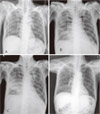Abstract
In April 2009, the first swine origin pandemic influenza (H1N1 2009) infection was reported in Mexico and United states and has since spread rapidly worldwide. Finally on June 11, 2009, WHO officially declared the first pandemic of the 21st century. Until March 2010, more than 213 countries reported laboratory confirmed cases of pandemic influenza H1N1 2009, including at least 16,931 deaths. The drug of choice for treatment and prophylaxis of pandemic (H1N1) 2009 influenza are the neuraminidase inhibitor (oseltamivir and Zanamivir). However, increased use of these drugs lead to the emergence of oseltamivir-resistant strains. We report a case of oseltamivir-resistant pandemic influenza (H1N1 2009) virus infection in a patient who were initially started with oseltamivir for laboratory-confirmed influenza. Patient's symptoms worsened despite the use of high-dose oral oseltamivir, and antiviral susceptibility test showed oseltamivir resistance (H275Y mutation). The patient resolved after treatment with zanamivir.
Figures and Tables
Figure 1
Serial chest radiograph findings. (A) normal chest radiograph at admission, (B) right middle lobe consolidation appears at pandemic influenza (H1N1 2009) diagnosis, (C) sustained right middle lobe consolidation with aggravated right loculated pleural effusion and new patchy consolidation in left upper lobe after 9 day oseltamivir use (D) improved chest radiograph at discharge.

Figure 2
Constrast-enhancing chest CT scan at the 9th day of oseltamivir use shows patchy consolidation with centrilobular nodule in right upper lobe, right lower lobe and bilateral pleural effusion.

Figure 3
Oseltamivir and amantadine resistant genetic substitution in M2 and NA of pandemic influenza (H1N1 2009) viruses from the patient. (A) Nucleotide sequence TAC (encoding tyrosine) in box exhibits that the viruses contains oseltamivir resistance maker (Y275) on their NA. (B) Nucleotide sequence AAT (coding asparagine) in box exhibits that infected viruses form the patient contains amantadine resistance maker (N31) on their M2. In A and B, single letters and numbers denote abbreviations of individual amino acids and amino acid sequences numbering. respectively.

References
1. World Health organization(WHO). World now at the start of 2009 influenza pandemic. 2009. 06. 11. Accessed 30 Mar 2010. Available at:
http://www.who.int/mediacentre/news/statements/2009/h1n1_pandemic_phase6_20090611/en/index.html.
2. World Health organization(WHO). Pandemic(H1N1) 2009. Disease outbreak news - situation update 93. Accessed 5 April 2010. Available at:
http://www.who.int/csr/don/2010_03_26/en/index.html.
3. WHO. Pandemic (H1N1) 2009 briefing note 1: Viruses resistant to oseltamivir (Tamiflu) identified. Wkly Epidemiol Rec. 2009. 84:299–399.
4. World Health organization(WHO). Pandemic(H1N1) 2009. antiviral drug resistance. Accessed 29 Mar 2010. Available at:
http://www.who.int/csr/disease/swineflu/frequently_asked_questions/antivirals/resistance/en/.
5. KCDC. Epidemiological study of five patients with oseltamivirresistant Influenza A(H1N1) in Korea. Public health weekly report. Accessed 10 Mar 2010. Avarilable at:
http://www.cdc.go.kr/kcdchome/jsp/home/information/had/INFOHAD0001Detail.jsp?menuid=100053&contentid=10810&appid=kcdchome&content=/contents/information/had/b/10810_view.html&pageNum=2&menutitleurl=null&q_had01=B&q_had02=2010&sub=4&q_had01=B&q_had02=2010&pageNo=5.
6. Centers for Disease Control and Prevention (CDC). Update: drug susceptibility of swine-origin influenza A (H1N1) viruses, April 2009. MMWR Morb Mortal Wkly. 2009. 58:433–435.
7. Centers for Disease Control and Prevention (CDC). A weekly influenza surveillance report: 2009-2010 influenza season week 14 ending April 10, 2010. Accessed 18 April 2010. Available at:
http://www.cdc.gov/flu/weekly/index.htm.
8. Moscona A. Global transmission of oseltamivir-resistant influenza. N Engl J Med. 2009. 360:953–956.





 PDF
PDF ePub
ePub Citation
Citation Print
Print


 XML Download
XML Download